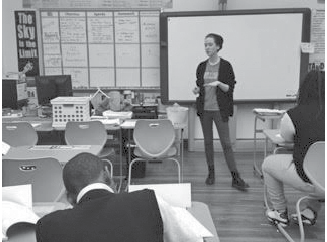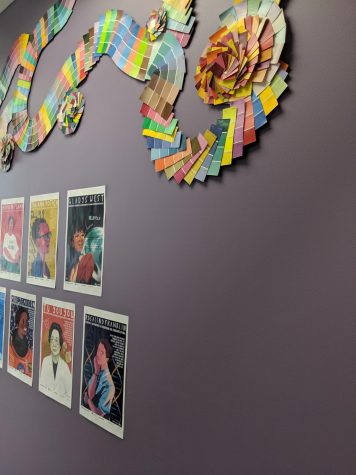Health Education in Public Schools: Let's Talk About Sex

Some of the most common questions volunteers at the Peer Health Exchange (PHE) hear in their classes include: “What if I’ve had blue balls for more than a day?” “How do I get rid of a hickey?” “Is it okay to wear two condoms?”
PHE is a national organization that trains college student volunteers to teach health curriculum in high schools. It has sites in six major cities, including Boston, San Francisco, New York City, Los Angeles, Chicago and the District of Columbia.
“I have been absolutely thrilled to see how thoughtfully Peer Health Exchange is responding to the needs of teens,” said Cassandra Bell, a member of the Board of Overseers for Peer Health Exchange of DC and a teacher at Eastern Senior High School. “[They’re] really moving towards empowering students with information and resources to make their own healthy decisions and, even more importantly, it’s connecting them with local providers.”
The volunteers are not licensed teachers, so their curriculum goes hand-in-hand with the curriculum taught at the high schools. In the past, volunteers would teach a series of content-based workshops, but the organization has taken strides to change that.
“They’re fulfilling a unique role of coming into ninth grade classrooms and giving students that information when they might not otherwise get it for another year, and when [students are] already being exposed to a lot of things just by being in high school,” Bell said.
In the District, the organization is trying a pilot program where volunteers teach high school students how to access important and credible resources for all aspects of their health. Many students are not aware of the information they have at their fingertips. This new program is critical to educating students. The volunteers go the extra mile by leading tours of local clinics and health centers.
Since most ninth graders in the District do not receive health and sex education because it does not fit into their schedule, there’s a gap in their knowledge on healthy decisions. PHE fills that gap.
“Every single thing they learn is so impactful for them because this is such an important time in their lives, learning about such serious stuff like drugs, alcohol, mental health and sex,” said Meg Carter, a volunteer for PHE and a junior at AU. “It’s such an honor to be part of their decision-making process.”
The health education standards in DC Public Schools (DCPS) are specific to each grade up until high school, where there is only one class that students can take any semester their schedule permits. This class is comprehensive and includes subjects like emotional health, human growth and development, nutrition, disease control and prevention, drugs and alcohol, sexuality and reproduction.
“One of the issues is that a lot of the students won’t take the class until 10th, 11th or 12th grade, after many of them have already engaged in some sort of sexual activity,” said Emily Meyer, a former volunteer for PHE and a senior at AU.
Jolynn Gardner is the Director of Public Health in the Department of Health Studies at AU. She believes that the public health community has a responsibility to make sure kids are as well prepared and as protected as possible, especially because there are so many youth already engaged in activities that are risky for pregnancy and STI transmission.
“We certainly know that abstinence is the best way to not get an STD and not get pregnant, but we also know in public health…that teenagers 100 percent practicing abstinence is not a reality.”
“The research tells us that the best sex education programs are programs that are comprehensive, that definitely introduce abstinence as an option,” Gardner said. “We certainly know that abstinence is the best way to not get an STD and not get pregnant, but we also know in public health…that teenagers 100 percent practicing abstinence is not reality.”
In 2013, 53.5 percent of high school students in the District had sexual intercourse in the past and 36.6 percent were currently sexually active, according to the Center for Disease Control and Prevention (CDC). Additionally, 70.1 percent of students used a condom during their last sexual intercourse while only eight percent used birth control pills.
Though DCPS’ curriculum is inclusive, the time allotted for it is not necessarily sufficient.
“The issue is, because it’s only one semester, there’s only so much you can fit in,” Meyers said.
Limited classroom time and low attendance rates of students in DCPS add an additional obstacle in successfully improving the students’ comprehension and understanding of the health and sex education curriculum.
DC Action for Children is an organization that provides data-based analysis on critical issues facing children and youth to encourage and support policies that heighten child well-being. They found that the truancy rate, or the percentage of students with more than 10 unexcused absences over the course of the year, was 42 percent in DC public high schools for the 2012-2013 school year. Furthermore, 30 percent of high school students had more than 20 unexcused absences in that same school year.
“Students just don’t go to class,” Meyers said. “It just doesn’t happen so, sure, they’re required to take [sex education classes] but are they there? And if they are there, are they paying attention? Chances are, ‘No.’ So it’s a very multifaceted problem.”
Gardner believes that the only way to lower misconceptions of sexual health in teenagers is by continuing the conversation as a community.
“We need to keep highlighting the fact that, for instance, in school districts where there’s either no sex education or abstinence-only education, we often see higher rates of teen pregnancies and higher rates of STDs as well,” she said. “But I think when we have those conversations and keep talking about it, we need to do so in a very patient, measured and consistent manner.”






